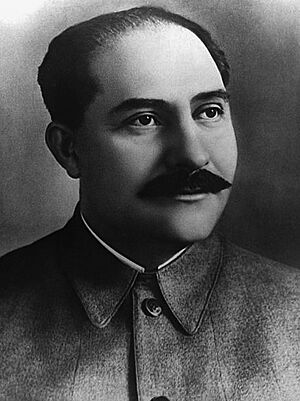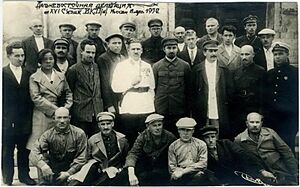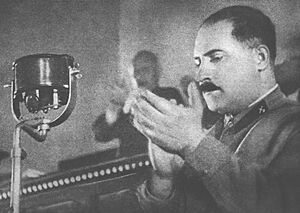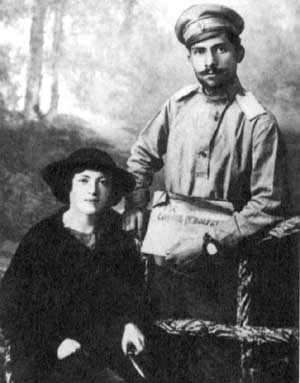Lazar Kaganovich facts for kids
Quick facts for kids
Lazar Kaganovich
|
|
|---|---|
|
Лазарь Каганович
|
|

Kaganovich in the 1930s
|
|
| First Deputy Premier of the Soviet Union | |
| In office 5 March 1953 – 29 June 1957 |
|
| Premier | Georgy Malenkov Nikolai Bulganin Nikita Khrushchev |
| Preceded by | Lavrentiy Beria |
| Succeeded by | Anastas Mikoyan |
| Deputy Premier of the Soviet Union | |
| In office 21 August 1938 – 5 March 1953 |
|
| Premier | Vyacheslav Molotov Joseph Stalin |
| Second Secretary of the Communist Party of the Soviet Union | |
| In office December 1930 – 21 March 1939 |
|
| Preceded by | Vyacheslav Molotov |
| Succeeded by | Andrei Zhdanov |
| Personal details | |
| Born |
Lazar Moiseyevich Kaganovich
22 November 1893 Kabany, Kiev Governorate, Russian Empire (now Dibrova, Kyiv Oblast, Ukraine) |
| Died | 25 July 1991 (aged 97) Moscow, Russian SFSR, Soviet Union |
| Resting place | Novodevichy Cemetery, Moscow |
| Nationality | Soviet |
| Political party | RSDLP (Bolsheviks) (1911–1918) CPSU (1918–1961) |
| Signature | |
|
Central institution membership
1930–1957: Full Member, 16th, 17th, 18th, 19th and 20th Politburo
1926–1930: Candidate Member, 14th & 15th Politburo 1924–25 & 1928–1939: Member, 13th, 15th, 16th, and 17th Secretariat 1924–26 & 1928–1946: Member, 13th, 15th, 16th, 17th & 18th Orgburo 1924–57: Full member, 13th, 14th, 15th, 16th, 17th, 18th, 19th, 20th Central Committee Other offices held
1955–1956: Chairman of State Committee on Labor and Salary
1948–1952: Chairman of State Committee on Materiel-Technical Supply for National Economy 1944–47 & 1956–57: Minister of Construction Materials Industry 1941: Chairman of Council on Evacuation 1939–40:People's Commissar of Oil Industry 1939: People's Commissar of Fuel Industry 1937–39: People's Commissar of Heavy Industry 1935–37,1938–42 & 1943–44: People's Commissar for Transport 1931–1934: First Secretary of the Communist Party of Moscow 1930–1935: First Secretary of the Communist Party of Moscow Oblast 1925–28 & 1947: First Secretary of the Communist Party of Ukraine |
|
Lazar Moiseyevich Kaganovich (Russian: Лазарь Моисеевич Каганович; November 22, 1893 – July 25, 1991) was an important Soviet politician. He was one of Joseph Stalin's closest helpers.
Born into a Jewish family in Ukraine, Kaganovich started as a shoemaker. He joined the Russian Social Democratic Labour Party in 1911. After the 1917 October Revolution, he held important roles in Bolshevik groups. He helped establish Soviet rule in areas like Turkestan. In 1922, Stalin put Kaganovich in charge of a special department. This helped Stalin gain more control over the Communist Party.
Kaganovich became the First Secretary of the Communist Party of Ukraine in 1925. By 1930, he was a full member of the Politburo and Stalin's deputy. In the early 1930s, he helped enforce strict rules for collecting grain in Ukraine. This contributed to a terrible famine known as the Holodomor. Later, he served as a People's Commissar (like a minister) for Railways, Heavy Industry, and Oil Industry. During World War II, he was part of the State Defense Committee.
After Stalin died in 1953, Nikita Khrushchev became powerful. Kaganovich quickly lost his influence. In 1957, he joined a group that tried to remove Khrushchev from power, but they failed. Kaganovich was then removed from his high position. He was sent to manage a small potash factory far away. In 1961, he was kicked out of the party. He lived the rest of his life as a retired person in Moscow. When he died in 1991, he was the last living Old Bolshevik. The Soviet Union itself ended just five months after his death.
Contents
Early Life and Family
Lazar Kaganovich was born in 1893. His parents were Jewish and lived in the village of Kabany, which is now in Ukraine. He spoke Yiddish at home. His parents had 13 children, but 6 of them died when they were babies.
Lazar had four older brothers who all joined the Bolshevik party. Some of his brothers also held important jobs in the Soviet government. For example, Mikhail Kaganovich became the head of the Aviation Industry. Lazar also had a sister named Rachel.
Lazar Kaganovich left school at age 14. He started working in shoe factories and cobbler shops. Around 1911, he joined the Bolshevik party. His older brother, Mikhail, had joined in 1905. In 1915, Lazar became a Communist organizer at the shoe factory where he worked. He was arrested that same year and sent back to his home village.
Revolution and Civil War Roles
In 1917, Kaganovich was the chairman of the Tanners Union. He was also the vice-chairman of the Yuzovka Soviet. In May 1917, he became a leader of the Bolshevik military group in Saratov. In August 1917, he led the Polessky Committee of the Bolshevik party in Belarus. During the October Revolution of 1917, he led the uprising in Gomel.
In 1918, Kaganovich worked as a Commissar for the propaganda department of the Red Army. From 1918 to 1919, he was the chairman of the Ispolkom (Committee) in the Nizhny Novgorod Governorate. From 1919 to 1920, he was the governor of the Voronezh Governorate. From 1920 to 1922, he was in Turkmenistan. There, he helped lead the Bolshevik fight against local Muslim rebels. He also led groups that punished those who opposed the Bolsheviks.
Becoming a Communist Official
In June 1922, Stalin became the General Secretary of the Communist Party. Two months later, Kaganovich was put in charge of the party's Organization and Instruction Department. This department was responsible for assigning all jobs within the Communist Party. Kaganovich helped place Stalin's supporters in important roles. He became known for working very hard and for being completely loyal to Stalin. He even said he would follow any order from Stalin.
In May 1924, Kaganovich became a full member of the Central Committee. He also became a Secretary of the Central Committee.
From 1925 to 1928, Kaganovich was the First Secretary of the Communist Party in Ukraine. He was also a candidate member of the Politburo in 1926. His job was to help build up Ukrainian communist leaders and encourage the use of the Ukrainian language. However, he was suspicious of high culture. He often argued with Ukrainian Bolshevik leaders like Vlas Chubar and Alexander Shumsky. In 1928, Stalin agreed to bring Kaganovich back to Moscow.
In Moscow, he returned to his role as a Secretary of the Central Committee. He held this job until 1939. He supported Stalin's fight against other groups within the Communist Party. He also backed Stalin's plan to quickly collectivize farming. This meant forcing farmers to join large collective farms.
In July 1930, Kaganovich became a full member of the Politburo. He stayed in this powerful position for 27 years.
Stalin's Key Helper
In December 1930, Vyacheslav Molotov became the head of the Soviet government. Kaganovich took his place as Stalin's deputy in the party leadership. He held this role until February 1935. During these four years, he was the third most powerful person in the Soviet Union, after Stalin and Molotov. He was in charge of party matters when Stalin was away.
In 1933 and 1934, he was the head of a special committee. This committee checked who could be a Communist Party member. He made sure that anyone who opposed Stalin was removed from the party. In 1934, at a big Communist Party meeting, Kaganovich was in charge of counting votes. He changed the vote count to make sure Stalin was re-elected as General Secretary. This was done even though another leader, Sergey Kirov, had received fewer opposing votes.
From 1930 to 1935, he was also the First Secretary of the Communist Party in Moscow. He later led the Moscow city party. During this time, he oversaw the destruction of many old buildings in Moscow. This included the Cathedral of Christ the Saviour. In 1932, he helped stop a workers' strike.
Building the Moscow Metro
In the 1930s, Kaganovich helped organize and lead the building of the first Soviet underground train system, the Moscow Metro. This system was named after him until 1955. The decision to build the metro was made in 1931, after Kaganovich gave a report.
On October 15, 1941, Kaganovich received an order to close the Moscow Metro. He was told to prepare plans to destroy it, as it was a very important target during the war. The metro was supposed to be destroyed, and its trains and equipment removed. On the morning of October 16, 1941, the metro did not open for the first time ever. This was the only day in its history that it did not work. By evening, the order to destroy the metro was cancelled.
In 1955, after Stalin died, the Moscow Metro was renamed. Kaganovich's name was removed.
The Famine in Ukraine (1932–1933)

In July 1932, Molotov and Kaganovich went to Kharkov, the capital of Ukraine at the time. They ordered the Ukrainian Communist party to collect a huge amount of grain from farmers. Every member of the Ukrainian party asked for less grain to be taken, but Kaganovich and Molotov refused. Later that month, they sent a secret message to Ukrainian leaders. It told them to collect more grain and punish farmers who did not give enough.
In August, Stalin and Kaganovich approved a new rule. It said that stealing or damaging state property, including farm property, could be punished by death. Kaganovich also sent a message to Ukrainian leaders, saying that grain collection was too slow.
Years later, a court in Kyiv investigated the causes of the 1932–33 famine, known as the Holodomor. The court pointed to Kaganovich's actions as part of the reason for the famine. The court noted that in December 1932, Kaganovich returned to Kharkiv. During a long meeting, Ukrainians begged to let farmers keep more grain for themselves and for planting next year. But Kaganovich refused. He sent a message to Stalin, saying the Ukrainians were "seriously hindering" grain collection.
Kaganovich also traveled to the Northern Caucasus in October 1932. He went there to deal with people who were stopping grain collection. When some Cossacks resisted, he had all the people from 16 Cossack villages removed. More than 1,000 people lived in each village. He brought in farmers from other areas to replace them.
He also visited other parts of the USSR and Siberia. He pushed for faster collectivization and punishments against the Kulaks (wealthy peasants). Kulaks were often blamed for the slow progress of collectivization.
Events in Poltavskaya
The village of Poltavskaya in the Kuban region strongly resisted collectivization. Lazar Kaganovich saw this as a plot by Ukrainian nationalists and Cossacks. He strictly enforced the policy of taking grain in Poltavskaya and the rest of Kuban. He personally oversaw the removal of local leaders and Cossacks.
Kaganovich believed the resistance in Poltavskaya was linked to Ukrainian ideas. He gave speeches in a mix of Ukrainian. He used a letter from a local Cossack leader, Grigorii Omel'chenko, who supposedly supported Cossack independence. This was used to justify his suspicions about the area. However, Kaganovich did not mention that many people in Poltavskaya had already seen their family members removed or shot in earlier years. Because Poltavskaya was seen as very rebellious, almost all of its 12,000 residents were sent to the north. This was part of a larger removal of 46,000 Cossacks from Kuban. Poltavskaya was also renamed Krasnoarmeyskaya.
"Iron Lazar" and the Purges
In early 1935, Kaganovich was replaced in his party organization roles by Nikolai Yezhov. Yezhov later became the head of the NKVD, the Soviet secret police. This change marked the beginning of a period known as the Great Purge. Kaganovich had chosen Yezhov in 1933 to be his deputy. In March 1935, Nikita Khrushchev replaced Kaganovich as the head of the Moscow party organization.
From 1935 to 1937, Kaganovich was the Minister for Railways. This was his first step into working more on economic matters. But in 1935, he played a big role in preparing for the Great Purge. Even before it officially started, he ordered the arrests of thousands of railway managers. They were accused of trying to cause problems. Before the first of the Moscow show trials in August 1936, Kaganovich and Yezhov reported to Stalin. They told him about their progress in forcing people to confess. Kaganovich also helped Yezhov become the head of the NKVD. He praised this as a "wise decision" by Stalin.
During the Great Purge, Kaganovich was sent to different places like Ivanovo and Smolensk. His job was to start firings and arrests. In Ivanovo, he ordered the arrests of local party leaders. He accused many officials of being "enemies of the people." His visit became known as the "black tornado."
In party meetings during the late 1930s, he gave speeches demanding more effort to find and punish "foreign spies" and "saboteurs." Because he was so harsh in carrying out Stalin's orders, people called him "Iron Lazar." While he was the Railways Minister, Kaganovich was involved in the deaths of many people. He signed lists that led to executions. He removed so many railway workers that one official warned that a whole railway line had no staff left. Between 1936 and 1939, Kaganovich's signature is on many execution lists.
Kaganovich became the People's Commissar for Heavy Industry in 1937. In August 1938, he was named a Deputy Chairman of the Council of People's Commissars. In 1939, he became the People's Commissar for the Oil Industry. During World War II, Kaganovich was a Commissar for military fronts. From 1943 to 1944, he was again the Minister for railways. In 1943, he received the title of Hero of Socialist Labour. From 1944 to 1947, Kaganovich was the Minister for Building Materials.
Later Years and Political Decline
After World War II, Kaganovich's political power decreased. When the State Defense Committee was formed to lead the war, Kaganovich was not initially included. In 1946, he was ranked ninth in power in the Kremlin.
In 1947, Ukraine did not collect enough grain after a dry spell. Kaganovich was sent to replace Khrushchev as the First Secretary of the Ukrainian Communist Party. Khrushchev was given a lower job. However, Kaganovich was soon called back, and Khrushchev got his old job back in December 1947.
From 1949 until Stalin's death in 1953, Kaganovich was in a difficult situation. This was because of anti-Jewish actions supported by the state. Many Jewish people were arrested, including Molotov's wife. Kaganovich, as a prominent Jewish leader, remained in his job. But he was no longer invited to meet Stalin socially. He was very worried during this time.
From 1948 to 1952, he was the Chairman of Gossnab. This committee was in charge of supplying materials to businesses.

After Stalin died, Kaganovich seemed to gain some power back. In March 1953, he became one of four First Vice-Premiers. He was also confirmed as a full member of the Praesidium (the new name for the Politburo). In 1955, he became the first Chairman of Goskomtrud.
However, his position quickly weakened as Nikita Khrushchev became more powerful. In the 1930s, Kaganovich had been Khrushchev's teacher. But Khrushchev had not forgotten when Kaganovich took his job in Ukraine in 1947.
In 1956–57, Kaganovich joined Molotov and others in trying to remove Khrushchev from power. This was partly because Khrushchev had given a Secret Speech in 1956. In this speech, Khrushchev criticized Stalin and the arrests of many innocent party officials. On June 6, 1956, Kaganovich was removed from his role as chairman of the State Committee on Labour and Wages. In June 1957, the Central Committee met to settle this dispute. Kaganovich was accused of "inactivity and crude violations of revolutionary legality." He was removed from the Praesidium, along with the other members of what was called the 'Anti-Party Group'. He was reportedly very scared he would be arrested. He called Khrushchev to ask for mercy. He was then given the job of director of a small potash factory in the Urals.
In 1961, Kaganovich was expelled from the Party. He then lived as a retired person in Moscow. His grandchildren said that after he was removed from the Central Committee, Kaganovich never shouted again. He became a loving grandfather.
In 1984, the Politburo considered letting him rejoin the Party. In his last years, he played dominoes with other retired people. He also criticized Soviet news for attacking Stalin. He said, "First, Stalin is disowned, now, little by little, it gets to prosecute socialism, the October Revolution, and in no time they will also want to prosecute Lenin and Marx." He had a heart attack shortly before he died.
Kaganovich died on July 25, 1991, at the age of 97. This was just before the events that led to the end of the USSR. He is buried at the Novodevichy Cemetery in Moscow.
Personal Life
Kaganovich started working at age 13. This experience shaped his views and preferences throughout his life. Stalin once told Kaganovich that he had a greater love for working-class people. As Kaganovich became more favored by Stalin, he felt he needed to improve his education. Stalin noticed that Kaganovich did not use commas correctly. So, he gave Kaganovich three months off to quickly learn grammar.
Kaganovich was married to Maria Markovna Kaganovich (1894–1961). She was also a Kievan Jew and had been part of the revolutionary movement since 1909. Mrs. Kaganovich worked as a powerful city official for many years. She directly ordered the demolition of the Iberian Gate and Chapel and the Cathedral of Christ the Saviour. The couple had two children: a daughter named Maya, and an adopted son named Yuri.
The Kaganovich family first lived a simple life, like most high-ranking Soviet officials in the 1930s. This changed when Stalin put Kaganovich in charge of building the Moscow Metro. The family moved into a very fancy apartment near the Sokolniki metro station. Kaganovich's apartment had two floors, which was very rare in the USSR. It also had a private garage and space for staff like butlers and drivers.
Decorations and Awards
- Order of Lenin, four times
- Order of the Red Banner of Labour (October 27, 1938)
- Hero of Socialist Labour (November 5, 1943)
See also
 In Spanish: Lázar Kaganóvich para niños
In Spanish: Lázar Kaganóvich para niños



